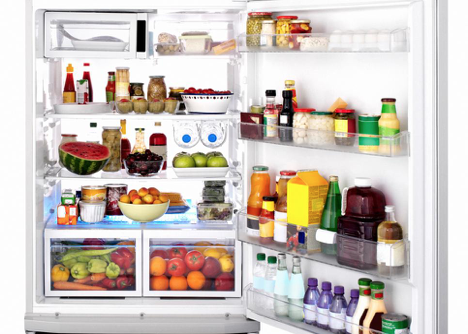
Habits to improve health
Minimize risks while shopping. To preserve the best flavour and safety while shopping, pick up refrigerated and frozen items last, and put them away first when you get home. Keep cold items separated from warmer items in your cart. Avoid bruised fruits and vegetables. Bacteria thrive on moist nutrient-rich surfaces.
Focus on date and temperature. Discard any perishable food that is past the “Best By” date marked on its package. Ensure your fridge temperature is 4 °C (40 °F) or below, and freezer is -18 °C (0 °F) or colder. While you’re at the fridge, ensure vulnerable moist and meaty/dairy foods don’t contaminate other fridge contents by storing each item in a container. Clean containers with hot soapy water before re-use.
Taste and nutritional quality changes over time. As food at room temperature is consumed for energy by micro-organisms, the remaining food product is changed. It may be left brittle and moist. This process of consumption and waste production often causes a change in taste and smell.
Concern yourself with safety over appearance. Smells, bruising, and taste are not reliable signs of food safety. Adhere to recommended storage methods and times posted by reputable health agencies, and don’t rely on colloquial rules of thumb not based on food facts. Store vulnerable items in the back of the fridge where it’s coldest, not in the door, and place items that may drip (such as meats and sliced fruit) at the bottom, where contaminated liquids can’t drip onto other food.
Important tips to handle foods safely:
- Meats: maximum two hours out of the fridge, including time coming home from the store and cooling off after cooking
- Milk: return to fridge quickly after use; discard served contents (don’t pour warm material from a serving container back into the original, colder container); store in coolest part of fridge (ie. not the door) between 0 and 4 °C
- Cooking: find correct cooking temperatures for different types of meats and recipes in a quality cookbook, and wash hands 20 seconds with warm soapy water after handling meats, eggs, and any uncooked mixes that contain them
- Surfaces: clean counters and cutting boards with sanitizing kitchen cleaner before and after contact with food; use one cutting board and knife for produce, and another for meats
- Handy information: Consult the Government of Canada’s handy chart of recommended storage times; it will encourage you to understand the need for safe food handling, and lists storage recommendations for many items
Note: The current recommended safe storage time for raw beef and pork in the fridge is 2-4 days, and for opened milk is 3 days
